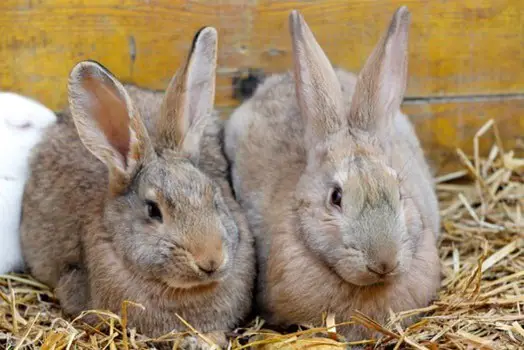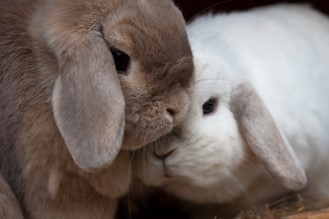To breed your rabbits, there are several points that you should initially think and plan before launching the method. The prime and most critical of these is the health of the rabbits at the moment for mating. This is due to the wellbeing of the female and male at the course of mating is crucial in concluding the completion of the mating.
Pets that are either obese or skinny will not be as fertile. Because of that, you should observe the dietary content of your rabbit’s meals and the entire fatty consumption. It is an utter essential that breeding creatures be held in ideal physical procreation circumstances and be given with the most reliable feasible nourishment. Here are a few pieces of information for the bucks and the does.
Does:
- The most frequent dilemma is when breeding females are obese. An obese female will not be as responsive to the buck, nor will she become gravid. The lipid deposits grow a natural obstacle that retains the infants from being cultivated.
- Seasons influence coupling:
- In the spring and solstice, females are a lot more responsive to mating as opposed to autumn and wintertide. This is due to the rise in the sustainable heat and period of morning hours. Hence, it is suggested that the female be sustained in an atmosphere that has at least fourteen to sixteen hours of illumination per day, to be responsive to males constantly.
- Solstice: You will want to have females more refreshing throughout the summer periods for them to be relaxed enough to mate.
- Wintertide: The majority of females will mate during the hottest fraction of the day through the winter season.
- Delivering females are more sensitive to mating than those females that are not delivering. This is especially accurate within the initial twenty-eight days following production.
Bucks:
- Juvenile bucks must not be coupled too constantly until they grow maturer as extreme breeding of juvenile bucks may lastingly disparage their triumph at breeding henceforth. One recommended program when initially breeding juvenile bucks is to manage them regularly, reaching 2-3 times per week.
- When the buck is mature enough, it can be employed every day for long years. A more adult buck can be employed 5 -7 times per day, following which a 5 – 7 day interval time should attend for the rabbit to sleep, and be equipped to favorably mate subsequently.
Tips for Rabbit Mating

Bring the female to the male rabbit’s enclosure, constantly. Rabbits are possessive, and if you bring your male to a female, the hair will fly completely. However, carry the female to the male, and she will stay on sound demeanor.
The male will propagate with the female, generally promptly. Following some snorts which notify him of the circumstances, the male hastily rounds to the back end of the female, ascend the female, achieves the rabbit coupling, and then slumps of the female with a groan.
Indications of victory: the fall-off and grunt. The male could likewise become completely masculine and beat the enclosure platform a few moments.
Infrequently, a male will discharge and still misfire. It could seem every inch like mating, though, he will not have struck the luck. Thus, when you transfer the female from the male, you might need to examine her aperture region for the appearance of sperm, observed as shining droplets.
A succeeding rabbit coupling before transferring the female appears to boost the completion percentage and offspring mass. Merely abandon the female in the enclosure. The male will gasp for air, be done in striking the deck, and reacquire concern in the female. He’ll, again, climb on her, she’ll raise her rear tail, and another mating will transpire.
It is essential that the female not pee for a solid 30 minutes following the coupling, to prevent wearing the sperm apart. It doesn’t occur frequently; however, experts have once witnessed a female pee after the mating, and the thick volume of orgasm drops to the ground.
Because of that, monitor the time when the mating transpires, and then pause for nearly 30minutes before transferring the female. The odds are quite great that the female will not emit on the point of in the male’s enclosure. Though if she acts, she’s in the proper position for a re-coupling.
Maintain an intimate eye on the couple rabbits, to guarantee that the female stays on complaisance. Anticipate transferring her instantly if she begins snarling or even hitting the male.
A few breeders prefer to view the third mating. And usually, third breeding could transpire throughout the half-hour you abandon the male and female mutually. However, you are normally content with two breedings.
Transfer the female to her enclosure. Throw grass within her enclosure, and whole oats or a tiny tad of black oil sunflower seeds toward the container as a prize. There’s added purpose too: to have her thought of the state of her urocyst. She’ll run right to the container or the grass, rather than going to the rear of her enclosure where her potty section is. It’s merely another expertise to provide the female with the most excellent opportunity at a large offspring.
The female discharges eggs for implantation (ovulates) inside 8-10 hours of coupling. The sperm is now present, and the female must get fertilized.
The female may get quite grouchy over the coming weeks. This is fine. Do provide her place. Desert her in her enclosure. Abandon her solely, assuming this is what she desires.
What should you do when the doe doesn’t cooperate with the buck?

Here are some methods that could support influence the female:
Redo the rabbit coupling in a day or two. The female may be eager then.
Monitor the weather prediction. Supposing the female rejected an endeavor at rabbit mating, you might intend to re-attempt the reproduction when the weatherglass is increasing, or the temperature is heating. This goes contemporary.
You might attempt exchanging enclosures. Place the male rabbit in the female’s enclosure and the female rabbit in the male’s cage for a late-night stay. Place the female back inside her enclosure where the male is expecting in the morning, or when you revert to the pets. She may be ready this moment, considering she is momentarily accustomed to the male’s smell.
If the female’s tail starts to jerk, or if the female starts turning to climb the male, the female is passionate, even if she rounds the male’s enclosure initially.
They’ve bred, now what?
If you’ve happily testified your rabbit’s reproduction, promptly the business to make is to anticipate for kittens and perform the wait-and-see policy of “is my pet expectant.” You’ll desire to make certain you are equipped with a cradle crate to place in her enclosure 28 days following reproduction.
Most frequently, rabbit mating is a fast and trouble-free activity, needing few to no support on the role of their human keepers. A surprisingly excellent indication is when the male produces a grunt when he’s finished performing his thing and plunges of the female toward his side.
Assuming you’re not convinced if the mating was victorious, it is a great approach to re-attempt all over from 6 to 10 hours following, and utterly redo what you took the initial period. If you are uncertain about whether or not bountiful reproduction transpires, you can discreetly carry the female to the male again in roughly 7-10 days. If she is unconcerned in him or seems irritable, she is presumably gravid.


